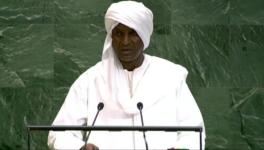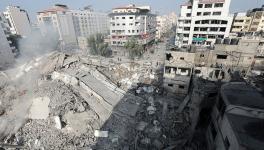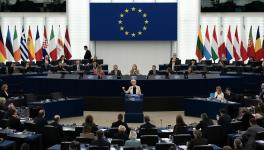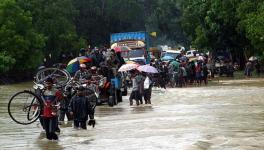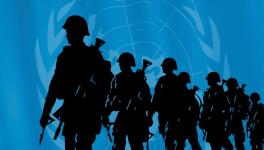For Children all Over the World, 2017 was Defined by War
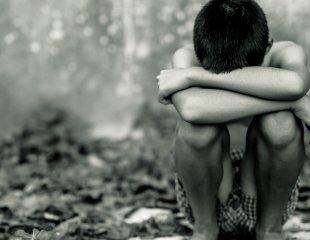
Image Courtesy: 271 EAK MOTO / Shutterstock.com
War is defined by noise. It is earthshattering. The sounds of exploding bombs and gunfire, of screams and pain: these are the aural coordinates of battlefields. The modern battlefield is not defined by remoteness. The new battlefield is often in the middle of a city, where fighters of all kinds move between destroyed houses to capture streets and hold neighborhoods. Families that cannot flee the battle get stuck in the midst of it. The sounds become normal, the movement of the earth a fact of life. There is a cold-blooded vocabulary for this. The bursts of sound energy are known as Impulse Noise and what the victim suffers from is Acoustic Trauma.
Worse are the shattering sounds and force of aerial bombardment. Jets can be heard in the distance, the whistle sound of the bombs as they fly to the earth, the unsuspected explosion that could be so close that it feels like one’s life has ended. The gap between thunder and lightening is a little like the gap between the whistle and the thunderous explosion. That time is a time of clenched teeth and prayer. No one, not even the most devoted atheist, is capable of being without god amidst the sounds of war.
Nor is reason the governing instinct in a war zone. Across the trenches of World War 1 in Europe a cat named Felix ran from the German to the English lines carrying messages of hope from one working-class fighter to another. When the officers heard of this, rather than smile at its charm they had the cat executed for treason. The English poet Heathcote Williams wrote of this ‘peace cat,’ one of the fifteen million souls that died in that war, ‘who’s barely ever mentioned/ but whose bloodstained paw-prints/are a lone, feline testament/to war’s absurdity.’ This is only one kind of absurdity, for war is itself – as Williams implies – an absurdity.
As war creeps from the trenches of abandoned fields into cities, it destroys the worlds of civilians. Bombs fall from the sky as fighters run from building to building. Between Dresden (Germany), where Allied fire bombing killed 25,000 German civilians in 1945, and Operation Phoenix (Vietnam), where US soldiers and their South Vietnamese allies killed over 45,000 Vietnamese civilians between 1968 and 1972, the idea of mass death by aerial bombardment or execution became normal. It is now normal to have armies enter a country and bomb it viciously or to enter into towns and villages to execute those suspected of being the enemy. All this is now normal. It is everyday life in Afghanistan.
War on Children
In the midst of such normality are children, many of whom not only grow up with the ferocious sound of bombs going off, but also see death before them when their lives have not yet begun. Entire generations in Afghanistan have come to this world surrounded by death, just as a generation in Iraq, in Syria and in Libya, in the broken parts of the Great Lakes region of Africa and in the wounded areas of Myanmar know too much of the sounds of gunfire and the images of death. Children are often in the crossfires of astoundingly loud days and nights. Their trauma is evident in the drawings done by children in refugee camps. Flashes of light and explosion are drawn at a very large scale. The impossibility of representing the noise is clear to the young artists. But it is what is so central to their ordeal.
A few days ago, the UN Children’s Agency (UNICEF) reported that the lives of over 220,000 children in eastern Ukraine are impacted by the proliferation of lethal weapons – including mines – in the area. ‘It is unacceptable that places where children could safely play less than four years ago are now riddled with deadly explosives,’ said Giovanna Barberis, the head of UNICEF in Ukraine. Every week, one more Ukrainian child is victim to these weapons. A few days after UNICEF made these numbers public, the United States government decided to sell lethal weapons to the government of Ukraine. US arms dealers will make close to $42 million in this sale. It will, most likely, ramp up a conflict that requires a negotiated settlement rather than more fighting.
UNICEF’s representative in Yemen – Merritz Rilano – said that the situation in that country is appalling, with one million children infected with cholera. What is striking is that 80% of the Yemeni population now needs humanitarian aid, but the impact on children has been especially stark – Geert Cappelaere, the regional director of UNICEF, said in November, ‘Yemen is one of the worst places on earth to be a child.’ Famine, cholera, and aerial bombardment: there is no worse fate. And yet, in the midst of all this, the West continues to sell weapons to Saudi Arabia and the UAE – the two countries that have led the war in Yemen. Britain and the United States are the leading merchants of war for these Gulf countries that continue this near genocidal war against Yemen.
Merchants of Death
All this would make one scratch one’s head. These wars seem so distant from the mundane lives of those who live in the West – bewildered by the complexity of the politics in Yemen and in Ukraine, eager for simple solutions, undone by the scale of the problem. What does this have to do with me, asks the innocent person in the West? I neither am author of these conflicts nor am I a beneficiary of them?
The innocent person is correct. But the finger does not point to the average person, who is certainly not directly culpable for these atrocities. But the fingers do point at the arms dealers, most of them based in the West, who have made trillions of dollars on war over the course of the past several decades.
From Sweden comes the latest report from the Stockholm International Peace Research Institute (SIPRI), which shows – conclusively – that the arms dealers are making a great deal of money on conflict, and these arms dealers are familiar – even household – names in the West. Lockheed Martin, the world’s leading merchant of death, had sales of $40.8 billion last year – 10.7% more than in 2015. Boeing, which had sales of $29.5 billion, and Raytheon, which had sales of $23 billion, follow Lockheed Martin as leading arms dealers in the world. Each of these firms is based in the United States.
Arms sales by US-based companies rose by 4% to $217.2 billion in 2016. Firms from the United States amount to 58% of the total arms sale of the top 100 arms dealers on the planet. Other firms of note include BAE systems of the United Kingdom ($23 billion in sales) and Northrup Grumman ($21.4 billion in sales).
Western arms dealers are by far the greatest purveyors of violence in the world.
These are companies that sell weapons to countries that can ill-afford to buy these weapons systems and to countries that are in the midst of fratricidal wars. Seven of the top ten arms dealers are based in the United States, while the rest are British, Italian, French or Trans-European (Airbus). These are the countries that are the most sanctimonious in the United Nations when it comes to war – selling weapons to all sides often, making money from pain, while preaching to the world about how belligerence should be avoided.
Helplessness
Afghan children run around playing a game called eagle (aaqab). The children are little birds – perhaps pigeons – while one child is the eagle who preys on them. Above their head swiftly moving is the Predator – a drone made by the San Diego based firm of General Atomics (the 46th largest arms dealer in the world). It is the real eagle. They are the real pigeons. The children say that they know the sound of the drone, the buzz of its propellers, the scent of danger in the air.
A song plays nearby. It is Nazia Iqbal singing, ‘My love you are far from me. These drones target you. I am helpless. I can’t stop them. My tears drop from my eyes like water from a spring.’
The US war on Afghanistan has been going on for over sixteen years, with immense amount of weaponry used to devastate the country. War has entered the nervous system of the Afghans, become normal and endless. Generations cannot imagine life without war. It has entered the songs and their games. It is the price paid by ordinary people around the world for the profits of the merchants of death.
Vijay Prashad is professor of international studies at Trinity College in Hartford, Connecticut. He is the author of 18 books, including Arab Spring, Libyan Winter (AK Press, 2012), The Poorer Nations: A Possible History of the Global South (Verso, 2013) and The Death of a Nation and the Future of the Arab Revolution (University of California Press, 2016). His columns appear at AlterNet every Wednesday.
This article was made possible by the readers and supporters of AlterNet.
Disclaimer: The views expressed here are the author's personal views, and do not necessarily represent the views of Newsclick.
Get the latest reports & analysis with people's perspective on Protests, movements & deep analytical videos, discussions of the current affairs in your Telegram app. Subscribe to NewsClick's Telegram channel & get Real-Time updates on stories, as they get published on our website.












